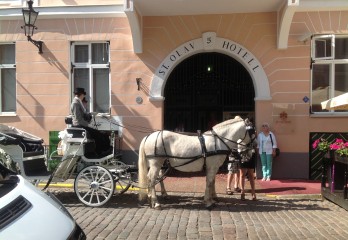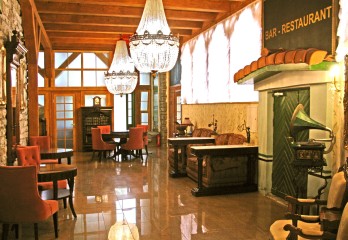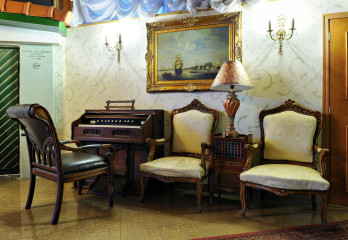Hotel history
The history of the building at 5 Lai Street dates back to 1437, when a wealthy town elder Gosshalk Borsteli had a dwelling house built here for his family. Over the centuries, the building has been repeatedly reconstructed and in the winds of architecture, its looks have changed. By today, this beautiful richly decorated Neo-Classical building with a spacious and quiet yard houses St. Olav's Hotel.
What hasn't changed, though, is the fact that the landlords have always been the most distinguished and respectable citizens. Among them, there have been representatives of various social status and nationalities: merchants, town councillors, town elders, clergymen, noblemen and warlords, statesmen and social figures.
Some of the most prominent people of them are:
Pastor of St Olaf's Church, Gabriel Elfring, who lived here in the 17th century;
descendants of the outstanding German noblemen the Bergs and Stackelbergs;
Paul von Kotzebue – General Adjutant from the brave seafarers' family, who faithfully and truthfully served his Russia.
In the 20the century the building housed the Union of Lindfors' Descendants' Printhouse Workers and Publishers, Jewish Literary and Drama Association called Bjalik and the editorial of the newspaper “Echo”. Until quite recently, the Scientific Library and the History Museum of Tallinn Polytechnical Institute were located here.
And what neighbourhood! Next door, there are houses once owned by celebrities, two of which belonged to Aleksei Menšikov, Governor of Estonia in Peter's time.
You'll know more about the people who lived in this block, hear the legends and stories about the mysterious backyards and even about King St Olaf himself when you join the exclusive excursion provided by our hotel - “Along the Secrets of St Olaf's Block”.
The block is surrounded by a defence wall that used to protect Archangel Michael's Convent built in the 13th century. The memory of those distant times is retained in the names of the defence towers such as Sister's Tower and Behind-the-Sisters Tower. Through a defence passage, it is possible to climb up the towers. On the site of the former church, you can now admire the Cathedral of Transfiguration - where, by the way, the subject of Peter the Great and an ancestor of the great Russian poet Pushkin, Аbraham Hannibal was wedded.
The name of the street St.Olaf's Hotel is located in is Lai, which means “wide”. In Lai Street you can also find the Museum of Applied Art, the Museum of Natural History and the Museum of Health.
Right next door, there is an exclusive sweet shop of the well-known confectionary factory Kalev – you can buy some marzipan as a souvenir from here.
And most certainly you'd like to visit one of the most famous sacred buildings of Tallinn, St Olaf's Church that dates back to the 13th century.
Against the rough Gothic skyline of our marvellous Old Town, you can't help admiring the outstanding spire of St Olaf's Church - the symbol of Tallinn. In the 16th century it was one of the highest churches in the world. The church was named after Scandinavian (Norwegian) King St Olaf Haraldson.


